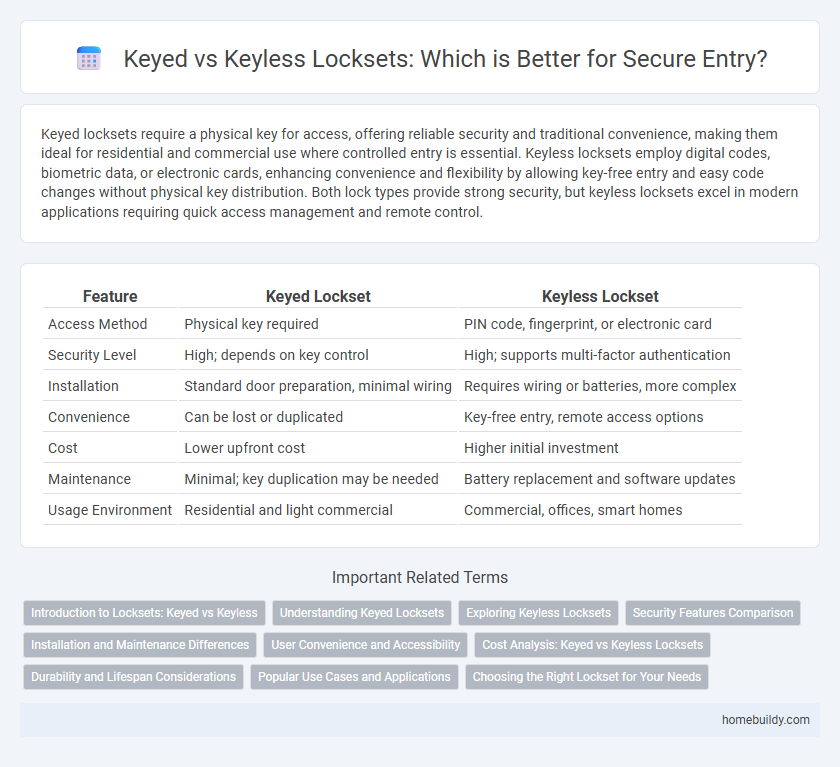Keyed locksets require a physical key for access, offering reliable security and traditional convenience, making them ideal for residential and commercial use where controlled entry is essential. Keyless locksets employ digital codes, biometric data, or electronic cards, enhancing convenience and flexibility by allowing key-free entry and easy code changes without physical key distribution. Both lock types provide strong security, but keyless locksets excel in modern applications requiring quick access management and remote control.
Table of Comparison
| Feature | Keyed Lockset | Keyless Lockset |
|---|---|---|
| Access Method | Physical key required | PIN code, fingerprint, or electronic card |
| Security Level | High; depends on key control | High; supports multi-factor authentication |
| Installation | Standard door preparation, minimal wiring | Requires wiring or batteries, more complex |
| Convenience | Can be lost or duplicated | Key-free entry, remote access options |
| Cost | Lower upfront cost | Higher initial investment |
| Maintenance | Minimal; key duplication may be needed | Battery replacement and software updates |
| Usage Environment | Residential and light commercial | Commercial, offices, smart homes |
Introduction to Locksets: Keyed vs Keyless
Keyed locksets require a physical key for operation, offering traditional security with the ability to control access through key duplication and management. Keyless locksets use electronic or mechanical codes, biometric data, or smartphone access, providing enhanced convenience and flexibility without the need for physical keys. Both types serve distinct security needs, with keyed locksets favored for simplicity and keyless models preferred for advanced access control.
Understanding Keyed Locksets
Keyed locksets utilize a physical key to control access, providing a traditional and reliable security method widely used in residential and commercial doors. These locksets offer durable mechanical components and varying levels of key control options, including master key systems for enhanced access management. Understanding the benefits of keyed locksets involves recognizing their compatibility with standard door hardware and the heightened security afforded by restricting key duplication.
Exploring Keyless Locksets
Keyless locksets enhance security by eliminating the risk of lost or duplicated keys through advanced technologies like keypad entry, biometric scanners, or smartphone integration. These locksets offer convenient access management, allowing users to set temporary codes or receive real-time usage notifications for increased control. Popular in residential and commercial settings, keyless locksets combine durability with smart features, making them a practical upgrade over traditional keyed locksets.
Security Features Comparison
Keyed locksets provide security through traditional mechanical key operation, offering robust resistance against forced entry and unauthorized access due to their physical key control mechanisms. Keyless locksets enhance security with programmable access codes, biometric verification, or smartphone integration, reducing risks associated with lost or stolen keys and allowing for easy access management. Both lock types vary in security application, with keyed locksets being reliable for physical security and keyless locksets excelling in access control customization and monitoring capabilities.
Installation and Maintenance Differences
Keyed locksets typically require precise alignment of lock cylinders and mortise preparation during installation, often needing professional locksmith services for accurate fitting. Keyless locksets feature simpler installation processes, commonly utilizing keypad or electronic mounting systems that can be executed with basic tools and minimal wall modification. Maintenance for keyed locksets involves regular lubrication and key duplication, whereas keyless locksets require periodic battery replacement and software updates to ensure reliable performance.
User Convenience and Accessibility
Keyed locksets provide secure access but require users to manage physical keys, which can be inconvenient and prone to loss. Keyless locksets enhance user convenience by enabling entry through PIN codes, biometric data, or smartphone integration, allowing quick and key-free access. This accessibility improvement supports seamless use for multiple users while reducing the risk of lockouts and improving overall security management.
Cost Analysis: Keyed vs Keyless Locksets
Keyed locksets typically cost between $15 and $50, offering a budget-friendly security solution with minimal upfront investment and easy maintenance. Keyless locksets, including electronic and smart locks, range from $100 to $300 or more, reflecting higher installation expenses and advanced features like biometric access and remote control. Evaluating long-term costs involves considering battery replacement, potential rekeying for keyed models, and software updates or connectivity for keyless options.
Durability and Lifespan Considerations
Keyed locksets typically offer enhanced durability due to their mechanical components made from hardened steel, providing a longer lifespan under frequent use. Keyless locksets, while convenient, rely on electronic or digital mechanisms that may require more maintenance and have a shorter lifespan due to battery dependency and potential wear on electronic parts. When choosing between the two, consider that keyed locksets withstand harsh environments better, whereas keyless locksets offer advanced security features but might need more frequent replacement or servicing.
Popular Use Cases and Applications
Keyed locksets are widely used in residential homes, commercial buildings, and secured storage areas where controlled access and physical key management are essential. Keyless locksets are popular in modern office spaces, smart homes, and high-traffic public facilities due to their convenience and integration with access control systems like keypads, biometric scanners, or smartphone apps. Both lock types serve specific needs: keyed locksets offer traditional security, while keyless locksets enhance flexibility and user-friendly access.
Choosing the Right Lockset for Your Needs
Keyed locksets provide reliable security through physical keys and are ideal for homes and businesses requiring controlled access and audit trails. Keyless locksets offer convenient, key-free entry using codes, biometrics, or smartphone apps, perfect for high-traffic areas or users seeking quick, flexible access without carrying keys. Selecting the right lockset depends on balancing security needs, user convenience, and installation complexity tailored to specific environments.
Keyed Lockset vs Keyless Lockset Infographic

 homebuildy.com
homebuildy.com